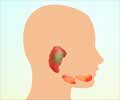Novel PET tracer tracks bacterial infections in lungs and differentiates bacterial infection from inflammation which is not possible by current imaging methods.

‘New radioactive tracer fluorodeoxysorbitol (18F-FDS) can identify and track bacterial infections in lungs.’





He points out, "18F-FDG PET, a widely commercially available imaging agent, is capable of imaging infection, but it cannot distinguish infections from other pathologies such as cancer and inflammation. Therefore, there is a great need to develop imaging agents with high specificity and sensitivity. There are still no specific imaging agents that can differentiate bacterial infection from sterile inflammation at an early stage."For this study, mice were inoculated with either live Klebsiella pneumoniae bacteria to induce lung infection, or the dead form of the bacteria to induce inflammation. Half of the mice with the live bacteria were imaged with PET/CT using either 18F-FDS or 18F-FDG on days 0, 1, 2 and 3 to monitor disease progression post infection. The other half were screened by bioluminescent imaging, and mice with visible infection were selected for follow-up PET/CT scans with 18F-FDS. For the inflammation group, half the mice were imaged with PET/CT using 18F-FDS and half using 18F-FDG from day 1 to day 4 post-inoculation.
While both 18F-FDS and 18F-FDG effectively tracked the degree of bacterial infection measured by bioluminescent optical imaging, only 18F-FDS was able to differentiate lung infection from lung inflammation.
Ng notes, "Bacterial infection represents a threat to human health, including hospital-acquired, implant-related, and multidrug-resistant infections. 18F-FDS whole-body PET/CT imaging in mice has shown to be a unique imaging technique that could differentiate infection from inflammation. This same technique could potentially be used in patients to identify infection sites and determine the bacterial infection class, so that patients could avoid taking antibiotics that are known to have no effect against specific bacteria."
He adds, "The interpretation of CT appearances of lung disorders can be complex if a differential diagnosis needs to distinguish between inflammation and infection. Thus 18F-FDS PET/CT could be initially used as a follow up after an inconclusive CT diagnosis for suspected bacterial lung infection. As proven clinical data accumulate over time, 18F-FDS PET/CT could become a new clinical standard for confirming bacterial infection in the lungs or other sites."
Advertisement
He also observes, "This and other new PET imaging agents demonstrate that molecular imaging and nuclear medicine can offer unique technologies for patient care and will continue to play a key influential role in healthcare."
Advertisement
Source-Eurekalert















